Budget Entry – Budget Users
The Budget Entry routine allows the Budget User to update or remove a budget account, export the budget or a budget account, add budget notes, review account history, and display general budget information.
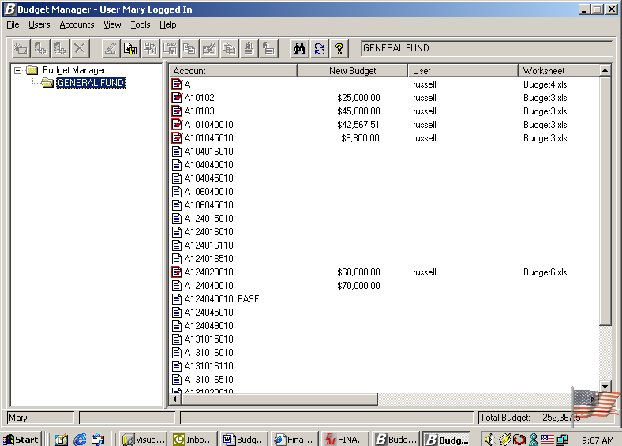
The name of the user who is currently logged in is displayed in the title bar of the window. You will only see those budgets for which you are defined as a budget user. The name of each budget to which the logged in user has access is displayed on the left-hand side of the window. The right-hand side of the window displays the accounts linked to that user as created through the User Account Chart Range Maintenance routine. The name of the selected budget is displayed in the top right-hand side of the window next to the shortcut icons. The bottom of the window reflects the name of the budget user and total budget (the sum of the New Budget amounts for those accounts to which the budget user has access).
Accessing Budget Entry Options
There are three ways in which you can access the options available within the Budget Entry routine.
·
Right-click with the mouse to access the options available within each folder.
·
Click on the drop-down menu at the top of the window and select the appropriate option.
·
Click on the active icons in the toolbar at the top of the window.
Back to top
General Budget Entry Options
The options contained in the View and Tools drop-down menu can be accessed regardless of whether you are a Budget User or Budget Administrator. These options are described below:
View Drop-Down Menu
NOTE: The options in this drop-down menu can also be accessed by right-clicking anywhere in the white area on the right-hand side of the window.
| Option
|
Action
|
| Sort
|
This option is used to change the manner in which the accounts are displayed on the window. Select Ascending to display accounts in numerical ascending order. Select Descending to display accounts in numerical descending order.
|
| |
|
| Details
|
This option is used to display detail for each account. The detail provided is as follows: new budget amount, budget user name, worksheet, last modified date/time, check out folder, category, and account status.
If Details is checked, the window would look like the following:
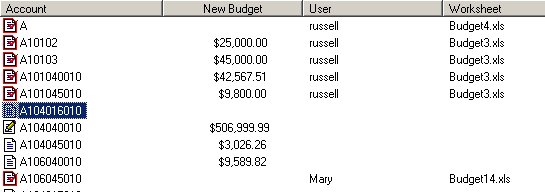
|
| |
|
| List
|
This option is used to display accounts in a list without detail.
If List is checked, the window would look like the following:

|
| |
|
| Small Icons
|
This option is used to display small size icons for each account when accounts are displayed in list format. If Small Icons is checked, the window would look like the following:
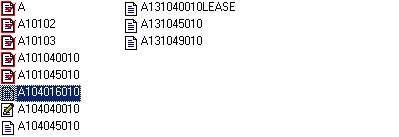
|
| |
|
| Large Icons
|
This option is used to display large size icons for each account when accounts are displayed in list format. If Large Icons is checked, the window would look like the following:
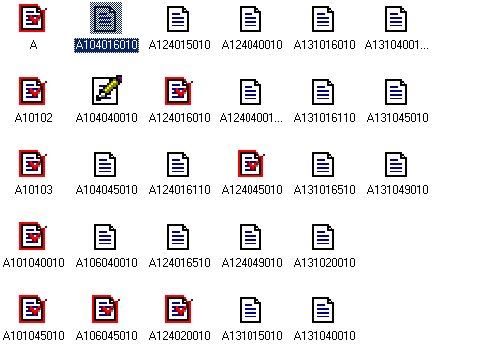
|
| |
|
| Refresh
|
This option is used to refresh the budget accounts on the right-hand side of the window with the most current data.
|
Tools Drop-Down Menu
| Option
|
Action
|
| Find
|
This option is used to search for a budget account number. The option can also be accessed from the  button in the toolbar. Select the option and type in all or part of an account code. The system will highlight the closest account match based on the search criteria entered. button in the toolbar. Select the option and type in all or part of an account code. The system will highlight the closest account match based on the search criteria entered.
|
| |
|
| Calculator
|
This option provides access to the on-line Windows calculator.

|
Back to top
Export Budget Account
The Export Budget Account option is used to export budget information to Microsoft Excel™.
This option can be accessed using one of the following methods:
Exporting One or More Budget Account
Exporting One or More Budget Account
·
Highlight the budget user name or account(s) that you wish to export to Excel, right-click on the selected account(s) and select the Export Budget Account option from the menu.
OR
·
Highlight the budget user name or account(s) and select the Export Budget Account option from the Accounts drop-down menu.
OR
·
Highlight the budget user name or account(s) and select the  button from the toolbar.
button from the toolbar.
Exporting All Budget Accounts
Exporting All Budget Accounts
·
Highlight and right-click on the budget folder and select the Export All Accounts option from the menu.
The Export Budget Accounts window displays.
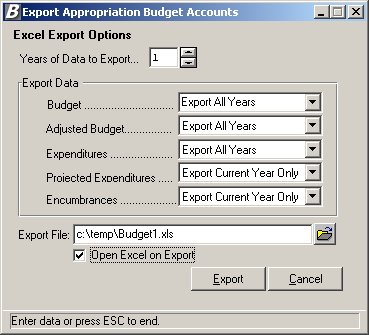
Entering Export Options:
1.
Enter the number of years of data to export. Type the number or use the up/down arrows to assist you in finding the correct number.
2.
Specify which years you wish to export for the following:
Budget - Indicate the year(s) for which you wish to include the original budget amount. Select Export All Years to include the original budget amount for each of the number of years specified. Select Export Prior Years Only to include the original prior year budget amount for each number of years specified. Select Export Current Year Only to include the original budget amount for the current fiscal year only. Select Don’t Export if you do not want to include the original budget amount for the current or prior fiscal years.
Adjusted Budget – Indicate the year(s) for which you wish to include the adjusted budget amount. Select Export All Years to include the adjusted budget amount for each of the number of years specified. Select Export Prior Years Only to include the adjusted prior year budget amount for each number of years specified. Select Export Current Year Only to include the adjusted budget amount for the current fiscal year only. Select Don’t Export if you do not want to include the adjusted budget amount for the current or prior fiscal years.
Expenditures - Indicate the year(s) for which you wish to include the expenditure amount. Select Export All Years to include the expenditure amount for each of the number of years specified. Select Export Prior Years Only to include the prior year expenditure amount for each number of years specified. Select Export Current Year Only to include the expenditure amount for the current fiscal year only. Select Don’t Export if you do not want to include the expenditure amount for the current or prior fiscal years.
Projected Expenditures - Indicate the year(s) for which you wish to include the projected expenditure amount. Projected Expenditures represent the Expensed amount plus the Encumbered amount minus the Liquidated amount.
Expensed
Amount
|
+
|
Encumbered
Amount
|
-
|
Liquidated
Amount
|
=
|
Projected
Expenditures
|
Select Export All Years to include the projected expenditure amount for each of the number of years specified. Select Export Prior Years Only to include the projected expenditure amount for each number of years specified. Select Export Current Year Only to include the projected expenditure amount for the current fiscal year only. Select Don’t Export if you do not want to include the projected expenditure amount for the current or prior fiscal years.
Encumbrances - Indicate the year(s) for which you wish to include the encumbrance amounts. Select Export All Years to include the encumbrance amounts for each of the number of years specified. Select Export Prior Years Only to include the prior year encumbrance amounts for each number of years specified. Select Export Current Year Only to include the encumbrance amounts for the current fiscal year only. Select Don’t Export if you do not want to include the encumbrance amounts for the current or prior fiscal years.
3.
Indicate the path and name of the Export file. Use the default path and export file name or enter a new path and file name. Use the browser  to locate the path of the export file.
to locate the path of the export file.
4.
Place a check in the Open on Export checkbox if you want the routine to open the Excel document upon execution of Export. Leave the box unchecked if you do not want to open Excel immediately upon Export.
5.
Press the Export button.
Below is a sample of the budget Excel spreadsheet.

Upon execution of the Export function, the selected accounts are checked out. The browser displays the name of the Excel spreadsheet. No other user can access these accounts until the budget accounts are imported or the budget export is undone.

NOTE: If you need to undo the budget export, select the account(s) and then select Cancel Budget Export option.
Back to top
Cancel Budget Export/Update
The Cancel Budget Export/Update routine is used to cancel the export of any budget changes so that they cannot be imported. This cancel process releases the account code(s) that were checked out so that other users may use them.
This option can be accessed using one of the following methods:
·
Highlight the budget account(s) for which you wish to undo the export, right-click on the selected account(s) and select the Cancel Budget Export/Update option from the menu.
OR
·
Highlight the budget account(s) for which you wish to undo the export and select the Cancel Export/Update option from the Accounts drop-down menu.
OR
·
Highlight the budget account(s) and select the  button from the toolbar.
button from the toolbar.
After selecting the Cancel Budget Export option, the below Question box displays.

Confirm that this is the correct action that you wish to perform. Select Yes if you wish to cancel/undo all selected budget accounts. Select No if you do not wish to cancel/undo the selected budget accounts at this time.
Back to top
Upon execution of the Undo function, the selected accounts are checked back in, the name of the Excel spreadsheet is removed from the browser, and other users can access the selected accounts.
Back to top
Import Budget Account
The Import Budget Account routine is used to bring in any changes that you made to the Budget Excel spreadsheet.
This option can be accessed using one of the following methods:
·
Highlight the budget account(s) that you wish to import, right-click on the selected account(s), and select the Import Budget Account option from the menu.
OR
·
Highlight the budget account(s) that you wish to import and select the Import Budget Account option from the Accounts drop-down menu.
OR
·
Highlight the budget account(s) that you wish to import and select the  button from the toolbar.
button from the toolbar.
After selecting the Import Budget Account option, the Import Options window displays.
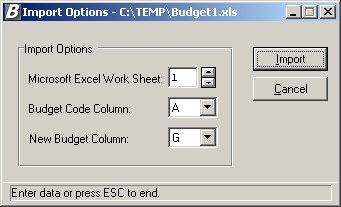
To Set Import Options:
1.
Enter the number associated with the Excel worksheet. Type the number or use the up/down arrows to assist you in finding the correct number.
2.
Enter the letter associated with the column in which the current budget account codes are located. Type the letter or use the up/down arrows to assist you in finding the correct letter.
3.
Enter the letter associated with the column in which the new budget amounts are located. Type the letter or use the up/down arrows to assist you in finding the correct letter.
4.
Press the Import button.
The system displays a message indicating that the Import process is complete. The new budget figures entered in the Excel spreadsheet are displayed for each account number.

Back to top
Update Budget
The Update Budget routine is used to change the budget amounts. NOTE: The system will not allow update of a budget amount for an account that is currently checked out  .
.
This option can be accessed using one of the following methods:
·
Highlight the account code(s) whose budget amount you wish to update, right-click on the selected account(s), and select the Update Budget option from the menu.
OR
·
Highlight the account code(s) whose budget amount you wish to update and select the Update Budget Accounts option from the Accounts drop-down menu.
OR
·
Highlight the account code(s) whose budget amount you wish to update and select the  button from the toolbar.
button from the toolbar.
The accounts that you selected are checked out, meaning that no other user can modify the budget code until you complete your transaction.
Updating Multiple Budget Codes
Updating Multiple Budget Codes
The Update Budget window shown below displays when you have selected more than one budget code. The Update Budget window displays the account code name, any notes, and the existing budget amount.
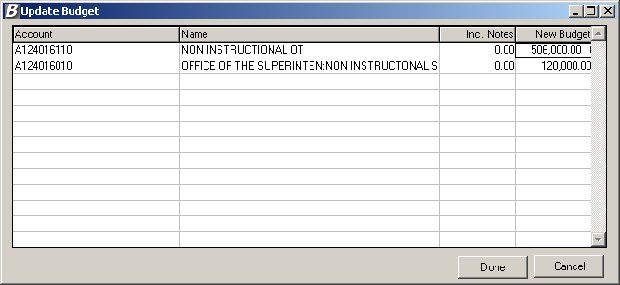
To Update Multiple Budget Codes:
1.
In the browser, click on the New Budget field for each account. Enter the new budget amount. NOTE: The New Budget figure may not be less than the sum of the new budget notes.
2.
Use the Enter, Tab or Up/Down Arrow keys to move to the next budget line.
3.
When you are finished entering the new budget figures, press the Done button.
The check out indicator is removed from each account code that was selected.
Updating Individual Budget Codes
Updating Individual Budget Codes
The Update Budget window shown below displays when you have selected only one budget code.
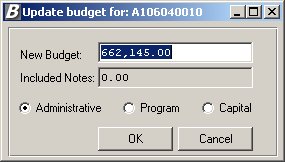
To Update a Single Budget Code:
1.
Enter the new budget amount. NOTE: The New Budget figure may not be less than the sum of the new budget notes.
2.
Change the account classification category if necessary. The categories are as follows: Administrative, Program or Capital.
3.
When you are finished entering the new budget figures, press the OK button.
The check out indicator is removed from the account code that was selected.
Back to top
Budget Notes
The Budget Notes routine is used to record notes that specify what the budget is being used for. For example, the Budget can be used to purchase equipment such as Computers, Printers, etc.
NOTE: The system will not allow split of an account that has notes.
This option can be accessed using one of the following methods:
·
Highlight the account code for which you wish to add or maintain budget notes, right-click on the selected account and select the Budget Notes option from the menu.
OR
·
Highlight the account code for which you wish to add or maintain budget notes and select the Budget Notes option from the Accounts drop-down menu.
OR
·
Highlight the account code for which you wish to add or maintain budget notes and select the  button from the toolbar.
button from the toolbar.
The account that you selected is checked out, meaning that no other user can modify the budget code until you complete your transaction. The Notes for Budget Account window displays.
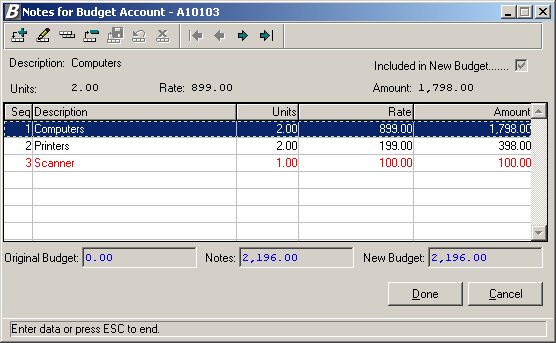
To Add a Budget Note Record:
1.
Press the Add button  .
.
The system assigns the next sequential number to the budget note item.
2.
Enter the text that describes what the budget is being used for.
3.
Check the Included in New Budget checkbox if you want the amount of the note to be included in the new budget amount. Otherwise, leave the box unchecked.
4.
Optionally enter the number of units.
5.
Optionally enter the rate associated with the note description.
6.
If you indicated a number of units and rate, the system calculates the extended amount. If you have not specified units and rate, enter a flat dollar amount.
7.
Press the Save button  .
.
Repeat steps 1 through 7 until you have added all appropriate budget note records.
8.
Press the Done button. NOTE: If you press the Cancel button without pressing Done, the budget note information is not saved in the system.
After pressing Done, the check out indicator is removed from the account code that was selected.
The account code on the right-hand side of the window displays a pencil icon  , which indicates that the budget account has notes associated with it. Refer to the screen capture below.
, which indicates that the budget account has notes associated with it. Refer to the screen capture below.

To Update a Budget Note Record:
1.
Highlight the budget note that you wish to update.
2.
Press the Update button  from the Budget Notes toolbar.
from the Budget Notes toolbar.
3.
Update the note description, Include in Budget flag, Units, Rate, and Amount as needed.
4.
Press the Save button  .
.
Repeat steps 1 through 4 until you have updated all appropriate budget note records.
5.
Press the Done button. NOTE: If you press the Cancel button without pressing Done, the changed budget note information is not saved in the system.
The check out indicator is removed from the account code that was selected.
To Delete a Budget Note Record:
1.
Highlight the budget note that you wish to delete.
2.
Press the Delete button  from the Budget Notes toolbar.
from the Budget Notes toolbar.
3.
Confirm that this is the correct budget note that you wish to delete.
Click Yes if you wish to delete the selected budget note.
Click No if you do not wish to delete the budget note at this time.
Repeat steps 1 through 3 until you have deleted all appropriate budget note records.
4.
Press the Done button. NOTE: If you press the Cancel button without pressing Done, the budget note information is not saved in the system.
The check out indicator is removed from the account code that was selected.
Back to top
Account History
The Account History routine is used to display the sequence of changes that took place for a selected budget account.
This option can be accessed using one of the following methods:
·
Highlight the account code for which you wish to review history, right-click on the selected account and select the Show History option from the menu.
OR
·
Highlight the account code for which you wish to review history and select the Account History option from the Accounts drop-down menu.
OR
·
Highlight the account code for which you wish to review history and select the  button from the toolbar.
button from the toolbar.
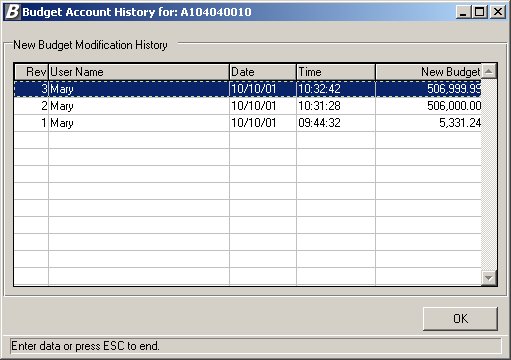
The information shown is for review purposes only and cannot be modified on this window. To return to the Account window, press the OK button.
Back to top
Account Properties
The Properties routine is used to display general information regarding a selected account.
This option can be accessed using one of the following methods:
·
Highlight the account code for which you wish to review properties, right-click on the selected account and select the Properties option from the menu.
OR
·
Highlight the account code for which you wish to review properties and select the Properties option from the Accounts drop-down menu.
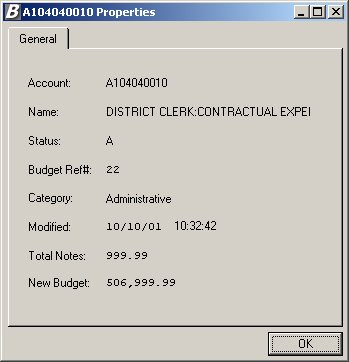
This window displays general budget account information including the account number, account description, account status, budget reference number, category, last modified date/time, total budget notes, and new budget amount.
Back to top

















